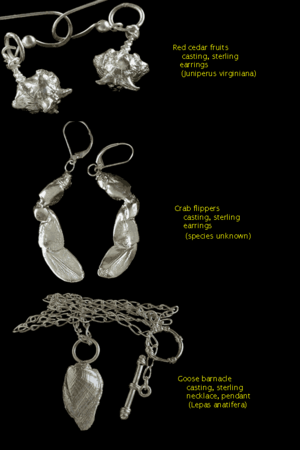
Biological art metal
Encyclopedia

Methods
Although, many metal art techniques may be used, biological art metal is generally rendered through advanced casting processes, in particular lost wax castingLost wax casting
Lost-wax casting sometimes called by the French name of cire perdue is the process by which a metal sculpture is cast from an artist's sculpture. Intricate works can be achieved by this method, primarily depending on the carver's skills...
processes. Cast waxes are taken from multi-part molds made from tin or platinum catalyzed silicone. The waxes are then invested in a plaster-like substance and then "burned out" at high temperatures leaving a negative space. The negative space is subsequently filled with molten metal. Vacuum, gravity or centrifugal casting may be employed. Metals are usually limited to gold, silver and bronze although stainless steel and cobalt chrome have been used. A high level of skill is needed in the preparation of molds and waxes in order to render sharp details.
Many metal artists forgo the mold and wax making steps and directly cast biological materials, but the resulting products are limited to those with burn-out characteristics similar to casting wax. For direct burn-out, favorite subjects are wooden specimens and soft insects (such as spiders) which burn out cleanly. Calcareous materials, such as hard-shell insect carapaces, sea shells, rocks, gar skins and crustaceans don't generally lend themselves to direct casting.
Origins
Biological art metal might be considered a modern elaboration on the Art NouveauArt Nouveau
Art Nouveau is an international philosophy and style of art, architecture and applied art—especially the decorative arts—that were most popular during 1890–1910. The name "Art Nouveau" is French for "new art"...
movement in jewelry design and art. In her authoritative 1985 work on the subject, Art Nouveau Jewelry, Vivienne Becker details the influence of nature on art nouveau jewelers such as Vever Aucoc, Lalique, Wolfers and Falize. Art nouveau jewelry designers (in France especially) were enormously influenced by art imported from Japan by Samuel Bing
Samuel Bing
Siegfried Bing , often referenced erroneously as "Samuel Bing", was a German art dealer who lived in Paris as an adult, and who helped introduce Japanese art and artworks to the West and was a factor in the development of the Art Nouveau style during the late nineteenth century.-Biography:Bing was...
and nature was an important theme in the japonisme. Bing writes,
In many ways, thus, the biological art metal movement represents a revival of the art nouveau in jewelry and metalwares.
"The Japanese artist ...is convinced that nature contains the primordial elements of all things, and ...nothing exists in creation, be it only a blade of grass, that is not worthy of a place in the loftiest conceptions of Art." (Becker, 1985).

